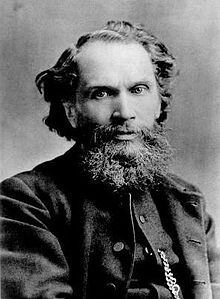Benjamin Waugh
This article needs additional citations for verification. (April 2016) |
Benjamin Waugh | |
|---|---|
 Waugh c. 1900 | |
| Born | 20 February 1839 |
| Died | 11 March 1908 (aged 69) Westcliff, Essex |
| Nationality | English |
| Education | Theological college, Bradford |
| Occupation | Minister |
| Religion | Congregationalist |
Benjamin Waugh (20 February 1839 – 11 March 1908) was a Victorian social reformer and campaigner who founded the UK charity, the National Society for the Prevention of Cruelty to Children (NSPCC) in the late 19th century, and also wrote various hymns.[1]
Early life
Waugh was born, the son of a saddler, in Settle, West Riding of Yorkshire. At the age of right he was deeply affected by the death of his mother and soon afterwards his father sent him to a small private school in Warwickshire run by his maternal uncle, a Congregationalist minister. When fourteen, he was apprenticed to Samuel Boothroyd, a prosperous draper and leading member of the Congregational Church in Southport, Lancashire. By the age of twenty Waugh had become secretary of the local branch of the United Kingdom Alliance, a leading temperance organisation. His religious commitment led to him giving up the drapery business although he remained friendly with his former employer whose daughter Sarah was to become his wife. Between 1862 and 1865 he studied at the Congregationalist Airdale Theological College in Bradford and on graduation, married Sarah Boothroyd and with her moved to Newbury near Reading as minister to the local Congregational church. A year later, he accepted the pastorate of the Independent Chapel at Maze Hill in Greenwich.
Career
As a Congregationalist minister in poverty-stricken East Greenwich, Waugh devoted himself to improving the conditions of the inhabitants. Critical of the workhouse system, the Poor law and aspects of the criminal justice system as it affected children, he wrote a book (The Gaol Cradle, Who Rocks It?, 1873) urging the creation of juvenile courts and children's prisons as a means of diverting children from a life of crime. He was elected to represent Greenwich on the London School Board from 1870 to 1876.[1]
Following a breakdown in his health in 1877, he resigned his post as Congregational minister and lwith his family left London for a quiet life in the Kent countryside from where he edited a widely read religious monthly periodical, The Sunday Magazine, which published stories and articles by several well-known authors, including Hesba Statton, as well as his own stories, 'Sunday Evenings with the Children', later published as a separate boo. of his own hymns, among which is "Now let us see thy beauty, Lord", which has appeared in several editions of the Methodist Hymn Book, in Congregational Praise and in the Australian Hymnbook, though not in its successor, Sing Alleluia.
London Society for the Prevention of Cruelty to Children
In 1884, he was a co-founder (with Sarah Smith, Lady Burdett-Coutts, Lord Shaftesbury and others)[1] of the London Society for the Prevention of Cruelty to Children (echoing a similar initiative in Liverpool), launched at London's Mansion House on 8 July. The London body's first chairman was veteran social reformer, Earl Shaftesbury. It evolved to become the NSPCC some five years later (14 May 1889), with Waugh as its first director and Queen Victoria as its first patron.
Family and homes
With his wife Sarah Elizabeth, Waugh had twelve children including daughters Edna, who would become a notable watercolour artist and draughtsman, and Rosa, who would follow in his footsteps as a social campaigner.
Waugh lived at a number of addresses including Oak Cottage, Shipbourne in Kent, Croom's Hill in Greenwich, and at 53 Woodlands Villas (today Vanbrugh Park) in neighbouring Blackheath. In 1884 he was living at 33 The Green, Southgate.[2] He later retired, in 1905, to live at 4 Runwell Terrace in Westcliff,[3] a suburb of Southend, Essex, where he died three years later, and was buried in the Southend borough cemetery.[1]
A blue plaque marks a property mistakenly believed to be that of Waugh's residence on Croom's Hill when it was installed in 1984 by the Greater London Council. English Heritage, the successor authority responsible for blue plaques correctly identifies Waugh's former home as 62 Croom's Hill.[4]
Gallery
-
Waugh's blue plaque at Croom's Hill, Greenwich
-
The plaque to Benjamin Waugh at 33 The Green.
-
Benjamin Waugh with some of his family of twelve children in about 1889.
References
- ^ a b c d Lee, Sidney, ed. (1912). . Dictionary of National Biography (2nd supplement). London: Smith, Elder & Co.
- ^ a b "A Walk in Southgate".
- ^ "Benjamin Waugh". Bygone Southend. Retrieved 24 March 2017.
- ^ "English Heritage". www.english-heritage.org.uk. Retrieved 24 March 2017.
External links
- 1839 births
- 1908 deaths
- People from Settle, North Yorkshire
- English Christian religious leaders
- English Congregationalists
- English philanthropists
- Members of the London School Board
- British reformers
- British social reformers
- National Society for the Prevention of Cruelty to Children people
- 19th-century British philanthropists
- Burials in Essex


![Benjamin Waugh's home once stood on this site at 33 The Green, Southgate.[2]](http://upload.wikimedia.org/wikipedia/commons/thumb/a/ad/33_The_Green%2C_Southgate.JPG/90px-33_The_Green%2C_Southgate.JPG)

